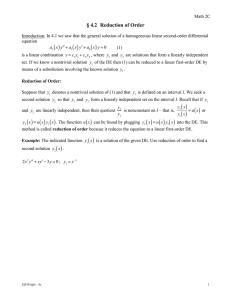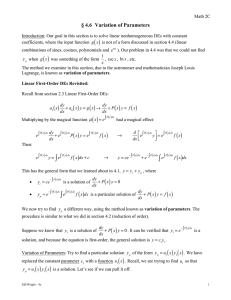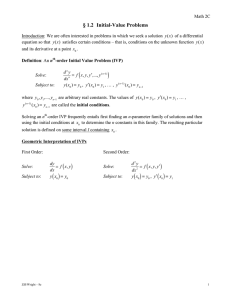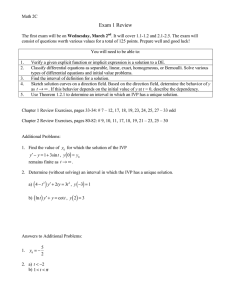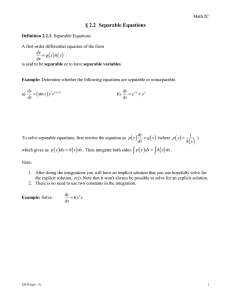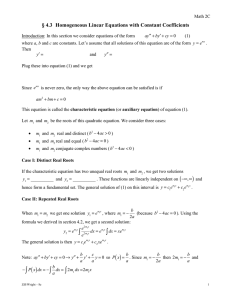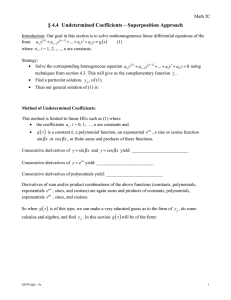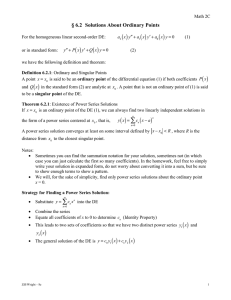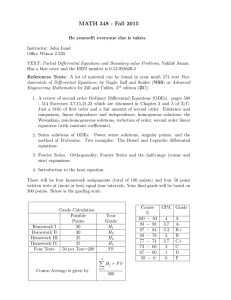§ 2.3 Linear Equations
advertisement
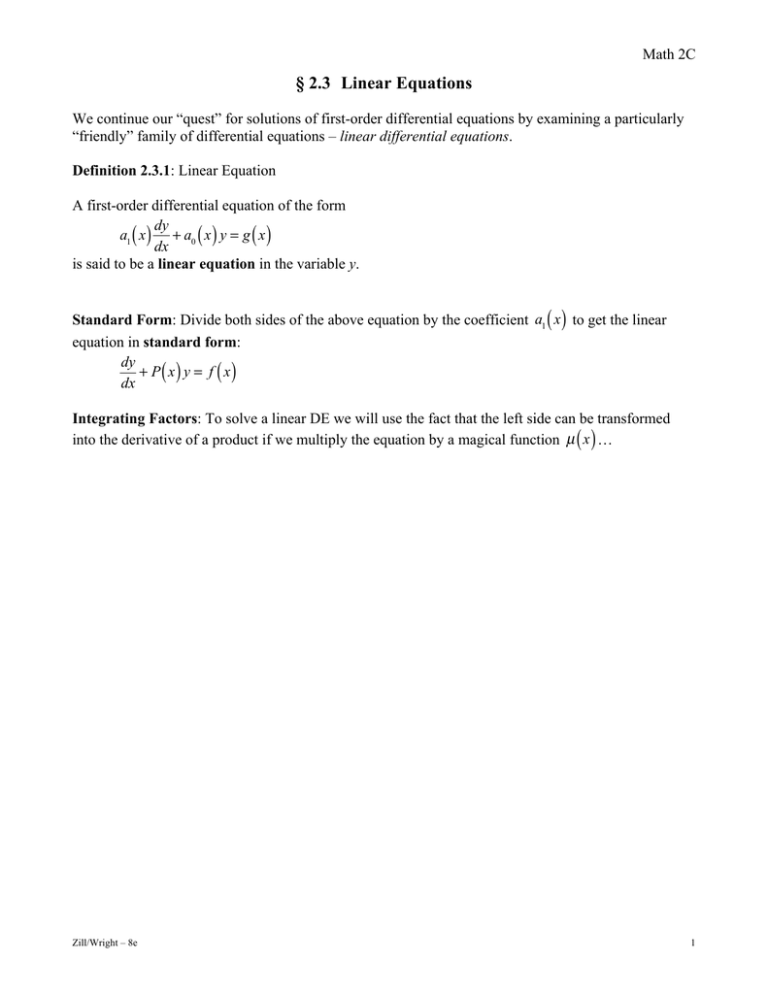
Math 2C § 2.3 Linear Equations We continue our “quest” for solutions of first-order differential equations by examining a particularly “friendly” family of differential equations – linear differential equations. Definition 2.3.1: Linear Equation A first-order differential equation of the form dy a1 ( x ) + a0 ( x ) y = g ( x ) dx is said to be a linear equation in the variable y. Standard Form: Divide both sides of the above equation by the coefficient a1 ( x ) to get the linear equation in standard form: dy + P( x) y = f ( x) dx Integrating Factors: To solve a linear DE we will use the fact that the left side can be transformed into the derivative of a product if we multiply the equation by a magical function µ ( x ) … Zill/Wright – 8e 1 Solving a Linear First-Order Equation 1. Put the equation in standard form: dy + P( x) y = f ( x) dx 2. Identify P ( x ) and find the integrating factor µ ( x ) = e ∫ when evaluating P( x ) dx . No constant of integration is needed ∫ P ( x ) dx , i.e. let c = 0. 3. Multiply both sides of the equation by µ ( x ) . 4. Verify the left side is the derivative of the product of µ ( x ) = e ∫ P( x ) dx and y and write it as such: d ⎡ ∫ P( x ) dx ⎤ ∫ P( x ) dx y⎥ = e f ( x) ⎢⎣ e dx ⎦ ( ) 5. Integrate both sides of the equation and solve for y. d µ( x ) y dx Example: Solve y′ − 2 y = 4 − x . Give the largest interval I over which the general solution is defined. 0 1 2 -1 -2 -3 -4 Zill/Wright – 8e 2 Notes on Existence and Uniqueness: 1. Suppose the functions P and f are continuous on I. We have shown that − P( x ) dx P( x ) dx − P( x ) dx y=e ∫ e∫ f x dx + ce ∫ is a one-parameter family of solutions of ∫ () dy dy + P ( x ) y = f ( x ) and every solution of + P ( x ) y = f ( x ) defined on I is a member of this dx dx − P( x ) dx P( x ) dx − P( x ) dx e∫ f x dx + ce ∫ family. We say y = e ∫ is the general solution of the DE on the interval I. ∫ () dy + P ( x ) y = f ( x ) in the normal form y′ = F ( x, y ) , we have dx δF δF = − P ( x ) . Since P and f are continuous on I, then F and F ( x, y ) = − P ( x ) y + f ( x ) and δy δy are also continuous on I. We can conclude from Theorem 1.2.1 that the IVP 2. If we rewrite dy + P ( x ) y = f ( x ) ; y ( x0 ) = y0 dx will have one unique solution, we just need to find the value of c in the general solution satisfying the initial condition. Example: Solve the IVP. Give the largest interval I over which the solution is defined. + ( sin x ) y = 2cos (cos x ) dy dx 3 ⎛π⎞ y⎜ ⎟ = 3 2 ⎝ 4⎠ x sin x − 1 : 8 7 6 5 4 3 2 1 -0.5π -0.25π 0 0.25π 0.5π -1 -2 Zill/Wright – 8e 3 Example: Find the general solution of dP + 2tP = P + 4t − 2 . Give the largest interval I over which the dt general solution is defined. 6 Solutions for c = −1, 1, 2, 3 are shown here. Note that as t → ∞ , P → ______ because 2 cet−t → ______. We call this term cet−t 5 2 4 a transient term. Not all solutions have them, but they are worth noting in applications, as 3 their contribution to the solution go to zero as the independent variable gets very large. 2 1 -2 Zill/Wright – 8e -1 0 1 2 3 4 ⎧⎪ dy + y = f ( x ) , y ( 0 ) = 1 , where f ( x ) = ⎨ 1 0 ≤ x ≤ 1 dx x >1 ⎪⎩ −1 Note: We want the solution to be continuous. Example: Solve the IVP Graph of f ( x ) : Graph of solution: 1 1 -1 0 1 2 3 -1 0 1 2 3 4 5 -1 -1 Zill/Wright – 8e 5 Example: Solve the IVP ty′ + 2 y = 4t 2 , y (1) = 2 4 3 2 1 -2 -1 0 1 2 -1 Zill/Wright – 8e 6
